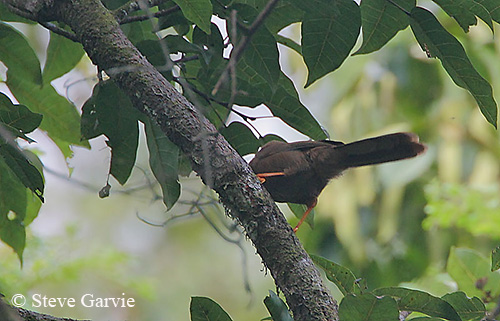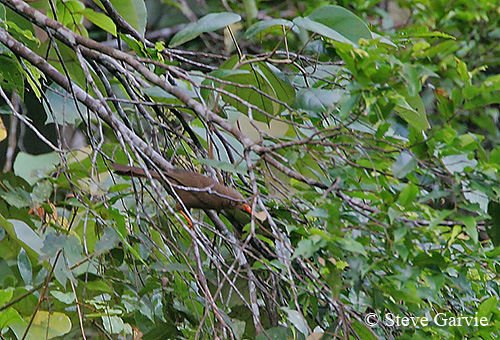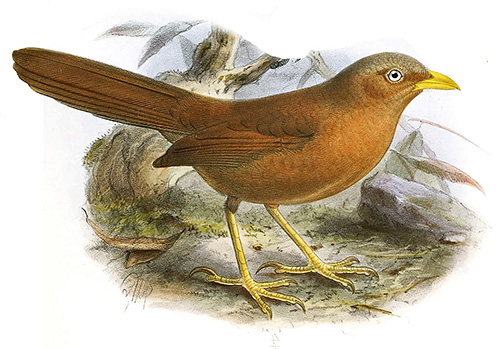Fr: Cratérope de Ceylan
Ang: Orange-billed Babbler – Ceylon Rufous Babbler
All: Orangeschnabel-Drosselhäherling
Esp: Turdoide Cingalés
Ita: Garrulo beccoarancio
Nd: Ceylonese Babbelaar
Sd: ceylonskriktrast
Photographers:
Steve Garvie
RAINBIRDER Photo galleries
Alan & Ann Tate
AA Bird Photography
Illustrator:
John Gerrard Keulemans (1842–1912)
Illustration’s origin: A History of the Birds of Ceylon Volume 1
Text by Nicole Bouglouan
Sources:
HANDBOOK OF THE BIRDS OF THE WORLD Vol 12 by Josep del Hoyo-Andrew Elliott-David Christie - Lynx Edicions - ISBN: 8496553423
The seasonality of mixed-species bird flocks in a Sri Lankan rainforest in relation to the breeding of the nuclear species, Orange-billed Babbler Turdoides rufescens
Bird Watching Tours in Sri Lanka
Wikipedia, the free encyclopaedia
Orange-billed Babbler or Ceylon Rufous Babbler
Argya rufescens
Passeriformes Order – Leiothrichidae Family
INTRODUCTION:
The Orange-billed Babbler or Ceylon Rufous Babbler is endemic to Sri Lanka, and is mainly found in the South West part of the island. It is a forest species, often seen in the deep jungle and well-vegetated habitats.
It feeds manly on insects, but it also consumes jungle berries. It often forages in mixed-species flocks. They are very noisy and can be heard at some distance.
This species builds a loose structure of grasses, twigs and leaves, well concealed in the thick forest vegetation.
It was formerly a subspecies of the Jungle Babbler (Argya striata).
The Orange-billed Babbler has restricted range in which it is described as fairly common to common or rare, depending on the area. The population is affected by degradation and fragmentation of the habitat, but currently, the species is not globally threatened.
DESCRIPTION OF THE BIRD:
Biometrics:
Length: 25 cm
The Orange-billed Babbler is a medium-sized babbler.
The upperparts, from crown to mantle are rufous-brown with pale greyish wash. Back, upperwing and long, graduated tail are darker, mostly rusty-chestnut.
On the underparts, chin, throat and upper breast are rusty-chestnut with indistinct greyish-white fine markings. Lower breast and upper flanks to upper belly are rufous-chestnut, whereas rest of underparts are duller. Underwing and undertail are brown.
On the head, crown and nape are dull greyish-brown. Lores, cheeks and ear-coverts are pale rusty-chestnut. The submoustachial area is rusty-chestnut with pale greyish tinge.
The strong bill is bright orange-yellow.
The eyes are white to pale bluish white, surrounded by pale greenish-yellow eyering.
Legs and feet are orange-yellow. The fairly long claws are pale yellowish.
Male and female are similar.
The juvenile is smaller in size but it resembles adults. The eyes are dark and the orange gape is prominent.
RANGE:
The Orange-billed Babbler is a resident breeding species endemic to Sri Lanka. It is mainly found in the SW of the island.
HABITAT:
The Orange-billed Babbler frequents the rainforest, and occurs in all the forests of the wet zone and in the hills to the highest elevations. It can be seen in thickets and bamboo scrub, and generally in well-wooded areas.
The species is visible from lowlands up to 2,100 metres of elevation.

CALLS AND SONGS: SOUNDS BY XENO-CANTO
The Orange-billed Babbler is known as a noisy bird, especially when a flock is present. We can hear continual chattering, squeaking and chirping produced by the birds. These high-pitched calls are used as contact between them.
These sounds are described as a short, petulant “tscheurk” slightly downturned, sometimes drawing out into a short trill. We can also hear a repeated “kraa-kraa-kraa-kraa”. While feeding, the birds produce lower pitched squeaking calls.
If they are alarmed, they utter again their high-pitched calls.
The birds are often heard before seen.
BEHAVIOUR IN THE WILD:
The Orange-billed Babbler feeds mainly on insects, and among them, large beetles (Coleoptera). But it probably also takes some small invertebrates and jungle berries.
This species usually forages at low level in trees and in the canopy, but also in the understorey. Insects and berries are taken by gleaning from leaves and while walking and hoping about on branches. But it can also use acrobatic poses to reach the food.
It frequently forages in mixed-species flocks and it is often the primary component of the groups. These flocks may include 40-50 individuals which are usually very noisy.
However, during the dry months (January-March), the Orange-billed Babbler is often seen in single-species flocks.
From an observation made from the town of Kudava towards the mountains of Sinhagala from November 2004 to December 2006, these flocks were probably composed of small breeding groups.
The behaviour of this species during the breeding season is poorly known. However, interaction between rivals usually 30-50 metres apart may occur at territory boundaries. This behaviour involves extended chorusing and displaying, with wing-spreading and bowing, while the birds fan and close the tail and flick the wings at every call note.
The Orange-billed Babbler builds a bowl-shaped nest on top of a platform of twigs. It is often placed in trees of various species, and also in fruiting trees in gardens near the forest edge.
During this observation, the babblers were clearly cooperative in their breeding habits, as well in nest-building as in chick-feeding.
The Orange-billed Babbler is resident breeder in Sri Lanka.
Its short, rounded wings only allow a weak flight confined only to short distances from one patch to another.
REPRODUCTION OF THIS SPECIES:
Following the same observation (made from the town of Kudava towards the mountains of Sinhagala, from November 2004 to December 2006), most of the breeding records were between January and March, and during this period, ten nests were found.
However, some other information places the breeding season in March, April and May and a secondary season in August-September. But the birds might nest throughout the year… More information is needed.
The nests were placed in several tree species including fruiting Rambutan trees, and other large trees, about 15 metres above the ground. Other nests were found in fruiting trees in gardens near the forest edge.
The nest of the Orange-billed Babbler is described as a bowl-shaped structure built on top of a small platform of twigs. The nest itself is made of fine vines and roots of ferns. An abandoned nest measured 83x90 mm inside, and the interior depth was 65 mm. It is usually concealed within dense masses of foliage.

The female lays 2-3 blue-green eggs or more (up to 5).
The Orange-billed Babbler performs cooperative breeding. Three and more adults were observed to take part in nest-building. At another site, four adults were feeding chicks and fledglings.
Groups of 4-5 individuals were frequently observed close to nests where only one or two adults were seen with chicks.
This observation was made in the NW sector of the Sinharaja World Heritage Reserve, the largest remaining patch of lowland rainforest, between 450 and 600 metres of elevation.
PROTECTION / THREATS / STATUS:
The Orange-billed Babbler is affected by degradation and fragmentation of its habitat through the recent decades, ca used by gathering of fuel-wood, clearance for agriculture expansion, fires, plantations and human settlements.
The species is generally described as common, although it is quite rare in the montane zone with only few records at high elevations.
The size of the population is unknown, but the species is not globally threatened at the moment.
The Orange-billed Babbler is currently considered as Least Threatened.

John Gerrard Keulemans
(1842–1912)